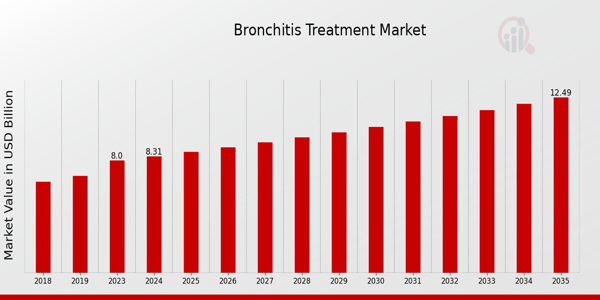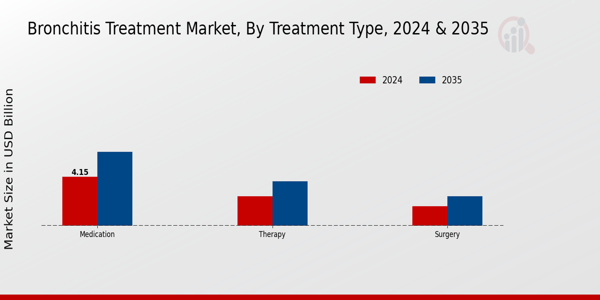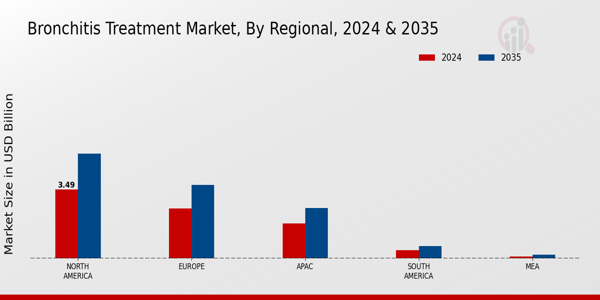Bronchitis Treatment Market Overview:
As per MRFR analysis, the Bronchitis Treatment Market Size was estimated at 8.0 (USD Billion) in 2023.The Bronchitis Treatment Market is expected to grow from 8.31(USD Billion) in 2024 to 12.5 (USD Billion) by 2035. The Bronchitis Treatment Market CAGR (growth rate) is expected to be around 3.78% during the forecast period (2025 - 2035).
Key Bronchitis Treatment Market Trends Highlighted
Due to a number of causes, the global market for bronchitis treatments is expanding significantly. Key market drivers include rising rates of chronic respiratory illnesses and growing awareness of how air pollution affects respiratory health.
The frequency of bronchitis cases is also rising due to the aging population, which is driving up demand for efficient treatment solutions. Additionally, new treatments for bronchitis are being developed as a result of pharmaceutical and biotechnology breakthroughs, which are encouraging market expansion.
There are several opportunities in this industry, particularly in developing nations with developing healthcare systems. There is a rising need for affordable and accessible treatment options, which creates a prime environment for market players to introduce innovative therapies and delivery systems.
Additionally, the integration of telemedicine and digital health technologies provides a platform for better patient management and engagement, thus opening new avenues for market expansion.
Collaborations and partnerships among stakeholders could further enhance product offerings and improve patient access. In recent times, there has been a notable trend toward personalized medicine, emphasizing the need for treatments that cater to individual patient profiles.
This shift is reflected in the growing focus on targeted therapies that address specific underlying causes of bronchitis rather than just symptomatic relief. Increased research on air quality and its relation to bronchitis has also influenced treatment approaches, guiding healthcare professionals toward preventive strategies.
Telehealth services are playing an important role, allowing patients to receive timely consultations and follow-ups. Overall, the market environment is evolving with a comprehensive approach to tackling bronchitis, combining innovation, accessibility, and patient-centered care.

Source: Primary Research, Secondary Research, MRFR Database and Analyst Review
Bronchitis Treatment Market Drivers
Increasing Prevalence of Respiratory Diseases
The Global Bronchitis Treatment Market is significantly driven by the rising incidence of respiratory diseases, including bronchitis. The growing air pollution and environmental factors are contributing to a higher number of individuals suffering from bronchial disorders, which directly leads to an increased demand for effective treatment solutions.
In urban areas, chronic exposure to pollutants such as particulate matter and harmful gases exacerbates pre-existing respiratory conditions and can lead to new cases of bronchitis. As more people seek medical intervention, healthcare systems are compelled to provide treatment options, thus bolstering the market for bronchitis treatment products.
Moreover, with an aging global population, the susceptibility to bronchial infections tends to rise, creating a larger patient base for clinicians to address. Increased awareness about the health impacts of smoking and exposure to second-hand smoke also drives individuals to seek remedies and therapies, further boosting market growth.
Thus, the interplay between environmental factors, demographic trends, and the awareness of respiratory diseases forms a substantial catalyst for the Global Bronchitis Treatment Market, encouraging ongoing investment and innovation in treatment options.
Advancements in Treatment Technologies
Innovative treatment technologies for bronchitis are profoundly influencing the growth of the Global Bronchitis Treatment Market. The introduction of new medications and inhalation devices has changed the landscape of bronchitis management, making it more efficient and patient-friendly.
Developments in drug formulation and delivery systems have led to more effective therapies that enhance patient adherence and optimize therapeutic outcomes.
The rise of digital health technologies, including telemedicine and mobile health applications, enables patients to receive timely consultations and guidance, thereby improving disease management. Such advancements not only broaden the range of treatment options available but also increase accessibility for patients across various demographics, thereby expanding the market reach.
Growing Focus on Preventive Healthcare
There is a notable shift towards preventive healthcare globally, which directly impacts the Global Bronchitis Treatment Market. Individuals and healthcare providers are increasingly prioritizing preventive strategies to avert the onset of bronchitis.
This trend fosters greater awareness surrounding respiratory health and encourages individuals to seek out early interventions rather than waiting for symptoms to escalate. Consequently, this proactive approach not only affects initial treatment demand but also promotes ongoing management and support solutions.
As healthcare systems aim to reduce future healthcare costs associated with unmanaged respiratory diseases, investment in preventive care and education is likely to gain traction, positioning the bronchitis treatment market for sustained growth.
Bronchitis Treatment Market Segment Insights:
Bronchitis Treatment Market Treatment Type Insights
The Global Bronchitis Treatment Market, segmented by Treatment Type, provided a nuanced understanding of the various approaches used in managing bronchitis.
The market was predominantly driven by the Medication segment, which held a valuation of 4.15 USD Billion in 2024 and is projected to reach 6.25 USD Billion by 2035. This segment's significance was underscored by the reliance on pharmaceutical interventions to alleviate symptoms and combat infections associated with bronchitis.
In comparison, the Therapy segment was valued at 2.5 USD Billion in 2024 and is expected to grow to 3.75 USD Billion by 2035. This indicated a growing recognition of the role that non-invasive techniques, such as pulmonary rehabilitation and inhalation therapies, played in improving patients' quality of life.
Meanwhile, the Surgery segment, which had a value of 1.66 USD Billion in 2024, is expected to increase to 2.5 USD Billion by 2035. Although this segment was notably smaller, it highlighted the importance of surgical interventions in severe or chronic cases where other treatments may not suffice.
Overall, the Medication segment dominated this market landscape, accounting for the majority share, due to its extensive application and effectiveness in treating bronchitis. The growth in the Global Bronchitis Treatment Market revenue was propelled by increasing rates of respiratory disorders globally and a heightened awareness of preventative care and effective treatment.
However, challenges such as the rising prevalence of antibiotic resistance and the need for innovative therapies posed hurdles for further expansion. Opportunities existed within the market for the development of new drug formulations and advanced therapeutic approaches to better manage symptoms and improve clinical outcomes.
Overall, the Global Bronchitis Treatment Market data reflected a promising landscape where medication remains the key treatment modality, while therapy and surgical options also hold crucial roles in patient management across various severity levels of bronchitis.
The potential trends in this segment revealed an ongoing evolution in treatment methodologies, adapting to ever-increasing patient needs and technological advancements within the healthcare sector.

Source: Primary Research, Secondary Research, MRFR Database and Analyst Review
Bronchitis Treatment Market Medication Type Insights
The Global Bronchitis Treatment Market segmentation by Medication Type offers a comprehensive overview of how various treatments are positioned within the industry. Among the key categories, Bronchodilators are crucial due to their ability to relieve respiratory distress, making them essential for patients experiencing chronic bronchitis symptoms.
Corticosteroids, known for their anti-inflammatory properties, play a significant role in reducing airway inflammation, thus supporting patients' quality of life. Antibiotics, while primarily used for bacterial infections, are vital in managing acute bronchitis caused by pathogens, contributing to the broader treatment landscape.
Mucolytics help in thinning mucus, thereby enhancing airway clearance, which is particularly important for those suffering from chronic obstructive pulmonary disease (COPD) associated with bronchitis. The interplay of these medication types not only drives the Global Bronchitis Treatment Market revenue but also shapes the market growth by addressing diverse patient needs and preferences within the industry.
This diversity in medication type offers both challenges and opportunities as healthcare providers strive to tailor treatment approaches to individual patient profiles.
Bronchitis Treatment Market Patient Type Insights
The Global Bronchitis Treatment Market is segmented by Patient Type, primarily consisting of Acute Bronchitis, Chronic Bronchitis, and Recurrent Bronchitis. Acute Bronchitis, often arising from infections, remains significant due to its high prevalence and often requires immediate medical attention.
Chronic Bronchitis, on the other hand, demonstrates a notable representation as it represents a chronic condition that is associated with long-term inflammation and is frequently observed in smokers or those exposed to air pollution, thus influencing treatment strategies and healthcare costs.
Recurrent Bronchitis, characterized by repeated episodes, is also gaining importance in the market as patients seek effective management solutions. The growth in awareness regarding respiratory health and advancements in treatment options contribute to the increasing demand across these patient types.
Understanding the dynamics of Global Bronchitis Treatment Market data is vital for stakeholders to navigate the challenges and explore opportunities in this evolving market landscape.
Bronchitis Treatment Market Route of Administration Insights
The Global Bronchitis Treatment Market showcases a diverse Route of Administration segment that plays a crucial role in the delivery of therapeutic agents for bronchitis management. The significance of inhalation methods stands out, as they provide direct delivery to the lungs, leading to faster relief and minimizing systemic side effects.
Oral administration, while common due to ease of use, might not always offer the same rapid onset of action, but plays an essential role in long-term management. Injection methods, although less prevalent, are critical for cases requiring immediate treatment or for delivering specific medications that cannot be administered orally.
The market segmentation reveals that inhalation dominates this landscape, primarily driven by the growing prevalence of respiratory conditions and advancements in inhalation technologies. The increasing awareness of treatment options, coupled with the growing global population, presents substantial opportunities for market growth.
Despite having significant opportunities, challenges such as regulatory hurdles and patient compliance may affect market dynamics and influence Global Bronchitis Treatment Market Statistics as it continues to evolve.
Bronchitis Treatment Market Regional Insights
The Global Bronchitis Treatment Market had strong activity across various regions, contributing significantly to its overall valuation. In 2024, North America led the market with a valuation of 3.49 USD Billion, which is expected to rise to 5.3 USD Billion in 2035, marking it as a major player in the industry due to high healthcare expenditure and advanced treatment options.
Europe followed, valued at 2.52 USD Billion in 2024, and anticipated to reach 3.72 USD Billion by 2035, indicating its significant contribution to the Global Bronchitis Treatment Market revenue through robust regulatory frameworks and extensive research activities.
The APAC region, valued at 1.77 USD Billion in 2024, with a rise to 2.55 USD Billion in 2035, reflected an increasing demand for effective treatments driven by rising pollution levels and healthcare improvement initiatives.
South America and MEA held comparatively smaller shares, valued at 0.42 USD Billion and 0.11 USD Billion, respectively, in 2024, with growth potential as the awareness of bronchitis management improved.
The market growth in these regions presents ample opportunities, driven by expanding healthcare access and initiatives aimed at improving treatment outcomes in respiratory diseases.

Source: Primary Research, Secondary Research, MRFR Database and Analyst Review
Bronchitis Treatment Market Key Players and Competitive Insights:
The Global Bronchitis Treatment Market is characterized by intense competition, as numerous companies strive to establish and enhance their market positions through innovative therapies and effective treatment options.
The increasing prevalence of bronchitis, driven by factors such as environmental pollution, smoking habits, and the rising incidence of respiratory diseases, has resulted in a growing demand for effective solutions. Companies are investing significantly in research and development to bring forth new pharmaceutical products and therapies, promising advancements in the treatment landscape.
Competitive strategies often involve strategic partnerships, mergers, and acquisitions aimed at broadening product portfolios and expanding geographical reach, ensuring that companies can meet the diverse needs of patients worldwide.
Roche has a significant presence in the Global Bronchitis Treatment Market, primarily leveraging its robust portfolio of respiratory medications. The company is known for its strong commitment to research and innovation, allowing it to develop effective treatment options tailored to respiratory diseases, including bronchitis.
Roche's strengths lie in its established brand reputation, extensive distribution channels, and strong financial backing, enabling it to conduct extensive clinical trials and deliver high-quality healthcare solutions.
Additionally, Roche's global reach allows it to access various markets and cater to a wide demographic, reinforcing its position as a key player in bronchitis treatment through consistent product availability and the introduction of novel therapies.
Mylan, a notable competitor in the Global Bronchitis Treatment Market, is recognized for its commitment to increasing access to affordable medications. The company specializes in the development and distribution of generic and specialty drugs, including treatments for respiratory conditions.
Mylan's strengths include its broad product portfolio, which features a range of formulations for bronchitis management, and its significant market presence across different regions. The company's focus on quality assurance and regulatory compliance ensures that its products meet stringent health standards, facilitating trust among healthcare providers and patients alike.
Mylan's strategic initiatives to expand its manufacturing capabilities and invest in innovative drug delivery systems position it well in the competitive landscape, allowing it to respond effectively to the evolving needs of the bronchitis treatment market.
Key Companies in the Bronchitis Treatment Market Include:
- Roche
- Mylan
- Amgen
- Johnson and Johnson
- Merck and Co
- Pfizer
- Teva Pharmaceutical Industries
- BristolMyers Squibb
- GlaxoSmithKline
- AbbVie
- Eli Lilly and Company
- Sanofi
- Novartis
- AstraZeneca
- Gilead Sciences
Bronchitis Treatment Market Developments
Recent developments in the Global Bronchitis Treatment Market highlight significant advancements and challenges faced by key players. Roche is focusing on innovative therapies to enhance treatment efficacy. Mylan has introduced generic alternatives to increase affordability. Amgen recently expanded its research on biologics that target underlying inflammatory processes in bronchitis.
Johnson & Johnson and Merck & Co. are investing in collaborative research to develop new formulations that incorporate long-acting bronchodilators. Pfizer's latest pipeline includes treatments combining corticosteroids and bronchodilators to improve patient outcomes, while Teva Pharmaceutical Industries emphasizes cost-effective solutions.
In terms of mergers and acquisitions, no substantial activity has been reported recently involving the primary companies within this market. The valuation growth for companies like GlaxoSmithKline and AbbVie is driven by ongoing research and development alignments, which are proving crucial in addressing the increasing global burden of bronchitis.
Sanofi and Novartis are also enhancing their product portfolios, responding to rising demand for advanced treatment options. AstraZeneca and Gilead Sciences continue to innovate, fostering competitive dynamics that shape the market landscape significantly as they explore synergistic partnerships and new treatment avenues.
Bronchitis Treatment Market Segmentation Insights
Bronchitis Treatment MarketTreatment TypeOutlook
- Medication
- Therapy
- Surgery
Bronchitis Treatment MarketMedication TypeOutlook
- Bronchodilators
- Corticosteroids
- Antibiotics
- Mucolytics
Bronchitis Treatment MarketPatient TypeOutlook
- Acute Bronchitis
- Chronic Bronchitis
- Recurrent Bronchitis
Bronchitis Treatment MarketRoute of AdministrationOutlook
- Inhalation
- Oral
- Injection
Bronchitis Treatment MarketRegionalOutlook
- North America
- Europe
- South America
- Asia Pacific
- Middle East and Africa
Scope:
| Attribute/Metric Source: |
Details |
| MARKET SIZE 2023 |
8.0(USD Billion) |
| MARKET SIZE 2024 |
8.31(USD Billion) |
| MARKET SIZE 2035 |
12.5(USD Billion) |
| COMPOUND ANNUAL GROWTH RATE (CAGR) |
3.78% (2025 - 2035) |
| REPORT COVERAGE |
Revenue Forecast, Competitive Landscape, Growth Factors, and Trends |
| BASE YEAR |
2024 |
| MARKET FORECAST PERIOD |
2025 - 2035 |
| HISTORICAL DATA |
2019 - 2024 |
| MARKET FORECAST UNITS |
USD Billion |
| KEY COMPANIES PROFILED |
Roche, Mylan, Amgen, Johnson and Johnson, Merck and Co, Pfizer, Teva Pharmaceutical Industries, BristolMyers Squibb, GlaxoSmithKline, AbbVie, Eli Lilly and Company, Sanofi, Novartis, AstraZeneca, Gilead Sciences |
| SEGMENTS COVERED |
Treatment Type, Medication Type, Patient Type, Route of Administration, Regional |
| KEY MARKET OPPORTUNITIES |
Increased prevalence of respiratory diseases, Advances in telemedicine solutions, Growth in personalized medicine approaches, Rising demand for home-based treatments, Expanding pharmaceutical research investments |
| KEY MARKET DYNAMICS |
Rising prevalence of respiratory diseases, Increasing awareness about treatment options, Advancements in drug formulations, Growing elderly population, Favorable reimbursement policies |
| COUNTRIES COVERED |
North America, Europe, APAC, South America, MEA |
Frequently Asked Questions (FAQ) :
The Global Bronchitis Treatment Market is expected to be valued at 8.31 USD Billion in 2024.
By 2035, the Global Bronchitis Treatment Market is projected to reach a value of 12.5 USD Billion.
The CAGR for the Global Bronchitis Treatment Market from 2025 to 2035 is anticipated to be 3.78%.
North America is expected to dominate the Global Bronchitis Treatment Market with a value of 3.49 USD Billion in 2024.
In 2024, the market value of the Global Bronchitis Treatment Market in Europe is expected to be 2.52 USD Billion.
The Medication segment of the Global Bronchitis Treatment Market is expected to grow to 6.25 USD Billion by 2035.
Prominent players in the Global Bronchitis Treatment Market include Roche, Mylan, Amgen, and Johnson & Johnson among others.
The Therapy segment is projected to be valued at 3.75 USD Billion in 2035.
The expected market value for the APAC region in 2024 is 1.77 USD Billion.
The Surgery treatment segment is projected to reach a market size of 2.5 USD Billion by 2035.
















